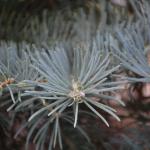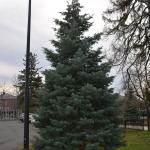A monthly e-newsletter from UMass Extension for landscapers, arborists, and other Green Industry professionals.
To read individual sections of the message, click on the section headings below to expand the content:
Hot Topics
UMass Garden Calendar Photo Contest
Ever take a great garden photo and think “this would be perfect for the UMass Garden Calendar?” We are pleased to announce that we are now accepting photos submitted by the public. Submissions will be judged by the calendar team at UMass Extension and may earn a spot in the 2019 Garden Calendar. For more information visit the Garden Calendar page.
Ticks are active at this time!
Remember to take precautions when working outdoors and to conduct daily tick checks. The UMass Amherst Laboratory of Medical Zoology tests ticks for Lyme Disease and other tick-borne pathogens. Visit the Tick Report website for more information.
Questions & Answers
Q: Are burlap or plastic barriers effective for preventing winter salt application damage to plants?
A: Yes, burlap or plastic barriers can be effective as physical barriers from salt spray; however, these types of barriers cannot prevent other types of damage. Salt damage can also occur from salt laden snow melt or from careless deicing salt applications. Salt laden snow melt damages plants by depositing sodium and chloride ions into the soil near plant roots. These ions can then be absorbed by the plant instead of needed mineral nutrients and can accumulate in toxic levels in the leaves. Careless applications can lead to rock salt being deposited in the soil in landscape beds. This salt can absorb water, making it unavailable to plants, causing water stress.
Other methods of preventing salt damage include reducing salt applications when possible, using de-icing materials other than sodium chloride, and applying applications carefully. Calcium chloride, magnesium chloride, potassium chloride, or calcium magnesium acetate are known to cause less injury to plants. It is also important to monitor the flow of runoff from snow piles, roads, and walkways. These are the areas where you are most likely to see salt damage to plants. Leaching soils by watering heavily can help remove salts from well-drained soils (this cannot be done with poorly draining soils).
Geoffrey Njue, Green Industry Sustainability Specialist, UMass Extension
Trouble Maker of the Month
Stigmina Needle Cast
Conifers are central features on the landscape during the winter months, when deciduous plants are bare and gray skies are common. Their dense canopies of dark green, blue or even yellow needles provide beauty, color and screening at a time when we need it most. However, for landscape spruces, Stigmina needle cast is increasingly leading to premature needle shedding.
The pathogen, Stigmina lautii, has been most commonly detected on blue spruce (Picea pungens) but has also been identified on white spruce (P. glauca), Norway spruce (P. abies) and other less common forest and landscape spruces. Symptoms of Stigmina needle cast are very similar to Rhizosphaera needle cast and often the two fungal pathogens can be found co-occurring on declining blue spruce. Older needles on lower canopy branches, especially towards the interior, turn brown and are prematurely shed from the canopy. When trees are stressed, symptoms can appear on current season’s needles late in the growing season. As needle loss worsens, trees have reduced resources for growth, maintenance and defense against insect pests and pathogens. Trees suffering from drought stress are more susceptible to needle cast infections.
Increasingly, Stigmina can be found acting alone on spruce trees in the landscape, suggesting it is becoming a more prominent pathogen in our region. Unlike Rhizosphaera, Stigmina can be found sporulating on green needles. This distinction can be used to successfully identify the fungus on infected spruces in the field. Overall, much remains to be learned about what role Stigmina plays in the decline of infected trees.
For more information visit the Stigmina Needle Cast Fact Sheet
Nicholas J. Brazee, UMass Extension Plant Pathologist
Plant of the Month
Abies concolor, White Fir
Tis the season to celebrate evergreens. Abies spp., or fir are some of the favorite Christmas tree species for New England. Although Abies concolor is not a common cut Christmas tree because it is slow growing, it is an excellent choice for the landscape. Abies concolor is an evergreen tree native to the mountain regions of the western United States. White fir has a pyramidal shape and grows 50-75’ tall and 20-30’ wide (although it can grow up to 100’). The needles have a unique arrangement, growing horizontally from the stem then curving up and out, giving them the appearance of a rib cage. The pale blue-green needles are 2-3” long. The 4-5” long, upright cones are yellow-green and cylindrical as they develop, maturing to brown. Cones shatter when mature to disperse seeds. Cones may not be produced for 40 years! The bark is smooth, white-gray with a few resin blisters.
White fir are best grown in slightly acid, well-drained soils in full sun to part shade. Although Abies concolor prefers a moist soil, it can tolerate some dryness and is more adaptable than other Abies species. White fir does best in areas with long winters and cool summers and does not like heat or humidity. Abies concolor does not have any serious insect or disease issues but balsam wooly adelgid, bark beetles, spruce budworms, aphids, bagworms, scale, root rot, needle rust, and twig blight can occur. Spider mites can be a problem when plants are grown in hot areas. Deer damage can also be a problem.
Cultivars offer dwarf forms and blue or silver needles. Cultivars include:
- ‘Candicans’ – silvery-blue needles
- ‘Compacta’ – dwarf form with an irregular habit
- ‘Dwarf Globe’ – dwarf form growing to 3’
- ‘Blue Cloak’ – powder blue needles that hang down
- ‘Glenmore’ – compact (30’) with longer needles
- ‘Wintergold’ – needs are yellow in winter and spring turning dark green in summer
Mandy Bayer, Extension Assistant Professor of Sustainable Landscape Horticulture, University of Massachusetts Amherst
Upcoming Events
Landscape Safety Conference
Have you ever been bitten by a mosquito? Removed an attached tick? Encountered a poisonous plant? Do you work with pesticides? If you answered “YES” to any of these questions, this Landscape Safety Conference is for you. This program will explore many topics that are important for landscapers, arborists, tree wardens, lawn care professionals, grounds managers, and essentially any professionals working in outdoor environments. UMass Extension and speakers from the MA Dept. of Agricultural Resources and the UMass Laboratory of Medical Zoology will come together to provide this day-long program. Topics include mosquito and tick prevention and safety; tick testing services provided by the Laboratory of Medical Zoology; poisonous plants you are likely to encounter and strategies to keep yourself safe; pesticide storage, transportation, and use safety; and PPE when working with pesticides.
- When: Tuesday February 6, 2018; 8:30am-3:30pm
- Where: Doubletree Hotel, Milford, MA
- Registration
Other Upcoming Events:
- 1/8-2/16: UMass Winter School for Turf Managers
- 1/11: Greenhouse Management and Production for 2018
- 2/6: Landscape Safety Conference
- 2/21: Principles and Fundamentals of Weed Science
- 3/6: 39th Annual UMass Community Tree Conference: Ecological Perspectives of the Urban Forest
- 3/13: State Regulations Pertaining to Invasive Plant Management
- 3/22: The Invasive Plant Issue and Invasive Plant Identification
- 3/29: Spring Kickoff for Landscapers: UMass Extension Landscape Education Day
For more information and registration for any of these events visit the UMass Extension Landscape, Nursery, and Urban Forestry Program Upcoming Events Page.
Additional Resources
For detailed reports on growing conditions and pest activity – Check out the Landscape Message
For commercial growers of greenhouse crops and flowers - Check out the New England Greenhouse Update website
For professional turf managers - Check out Turf Management Updates
For home gardeners and garden retailers - Check out home lawn and garden resources. UMass Extension also has a Twitter feed that provides timely, daily gardening tips, sunrise and sunset times to home gardeners, see https://twitter.com/UMassGardenClip
Diagnostic Services
A UMass Laboratory Diagnoses Landscape and Turf Problems - The UMass Extension Plant Diagnostic Lab is available to serve commercial landscape contractors, turf managers, arborists, nurseries and other green industry professionals. It provides woody plant and turf disease analysis, woody plant and turf insect identification, turfgrass identification, weed identification, and offers a report of pest management strategies that are research based, economically sound and environmentally appropriate for the situation. Accurate diagnosis for a turf or landscape problem can often eliminate or reduce the need for pesticide use. For sampling procedures, detailed submission instructions and a list of fees, see Plant Diagnostics Laboratory
Soil and Plant Nutrient Testing - The University of Massachusetts Soil and Plant Nutrient Testing Laboratory is located on the campus of The University of Massachusetts at Amherst. Testing services are available to all. The function of the Soil and Plant Nutrient Testing Laboratory is to provide test results and recommendations that lead to the wise and economical use of soils and soil amendments. For complete information, visit the UMass Soil and Plant Nutrient Testing Laboratory web site. Alternatively, call the lab at (413) 545-2311.


